From an artist’s monthly listeners to downloads of an individual podcast episode, it’s obvious that Spotify is a company obsessed with statistics. But in 2024, only one metric really mattered — profitability.
The nearly-ubiquitous streaming platform turned a profit for the first time in 18 years, following two subscription price-hikes and more high-profile media acquisitions. Bringing in a net profit of over $1.18 billion, the userbase also rose to 263 million paying subscribers. The rollout of new features, user interface overhauls, and an emphasis on full-screen video integrations all continued to drive Spotify’s position as the de facto leader in on-the-go audio streaming.
It’s hard to imagine an industry without Spotify at this point. But how did the once-humble Swedish media giant get started? And what are CEO Daniel Ek’s goals for the next five years? Read on to unpack the organic marketing strategies and forward-thinking positioning that enabled Spotify to become the world’s most popular audio streaming service.
What Is Spotify’s Marketing Strategy?
Spotify’s marketing strategy is centered around the three main principles of personalization, emotion, and data. Everything that Spotify does begins with considering the end user; whether it be through personalized playlists or user data-driven campaigns, they’re a brand that truly knows how to focus on making sure their audience receives the most positive experience possible. With that, let’s break it down.
Personalization
Spotify has always been at the forefront of personalization — they even have a dedicated VP of Personalization. Through machine learning, Spotify leverages users’ listening habits and historical behaviors to inform the types of albums and playlists that are shown on a users’ home screen. Reinforcement Learning, or RL, is then used to predict what a user might want to listen to in the future, so as to maximize the ultimate, long-term reward that users get from the platform – and keep them on it.
In 2023, Spotify began experimenting with generative AI tools, including an AI DJ feature that offers a curated selection of music with spoken commentary about the tracks and artists. This friendly automated persona signified a subtle shift that turned Spotify into more of a lean-back, passive listening experience: one based more on the platform’s recommendations rather than intentional user selection. Playlists shared on the platform now support a ‘Smart Shuffle’ algorithm that blends suggestions generated based on taste profile and user data with curated recommendations and intentional ordering.
Spotify has not been shy about pushing their Reinforced Learning with Human Feedback model, where users essentially ‘teach’ the algorithm to become better at accounting for taste and personal preference every time they play or skip a song — creating the perfect foundation for continual curation and improved recommendations.
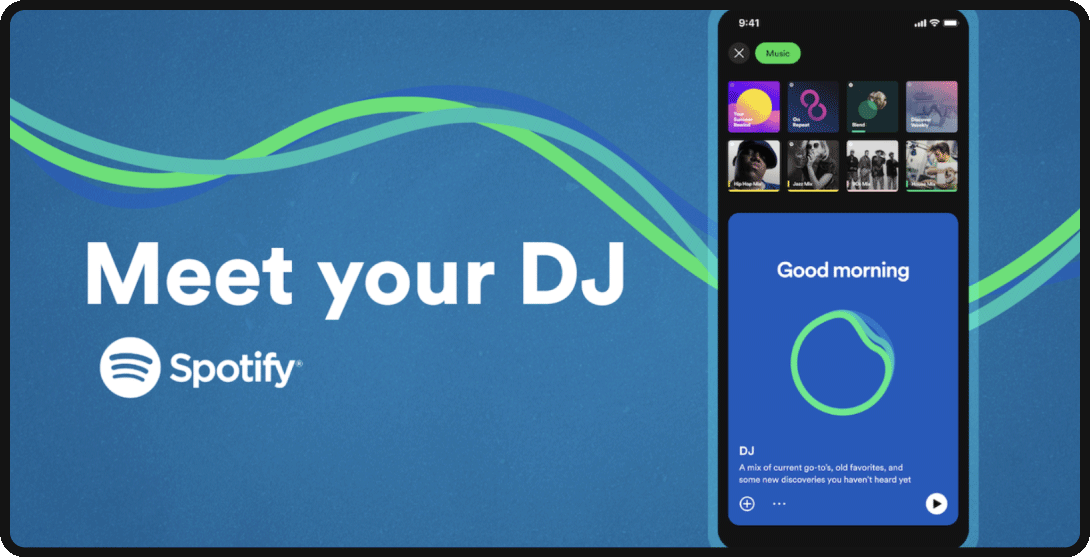
Emotion
Spotify has made passionate, dedicated fans on a global scale by positioning itself as a tech platform that understands the value of the individual. By tapping into human emotion, the company naturally builds user engagement and loyalty. Emotion can be an incredibly powerful marketing tool — particularly when it comes to music. Spotify’s marketing and UI leverages the relationship between music and emotion, building their strategy around what music means to people.
For example, many people associate music with the idea of memory and nostalgia, so Spotify creates the “Playlist in a Bottle,” which lets users create a musical time capsule that will be unlocked in the future. Since users have to wait a year to “unlock” their playlist, this nostalgia-steeped feature essentially locks a user into their Spotify subscription for another year, as well as providing an opportunity for organic UGC and social sharing when the time eventually comes around.
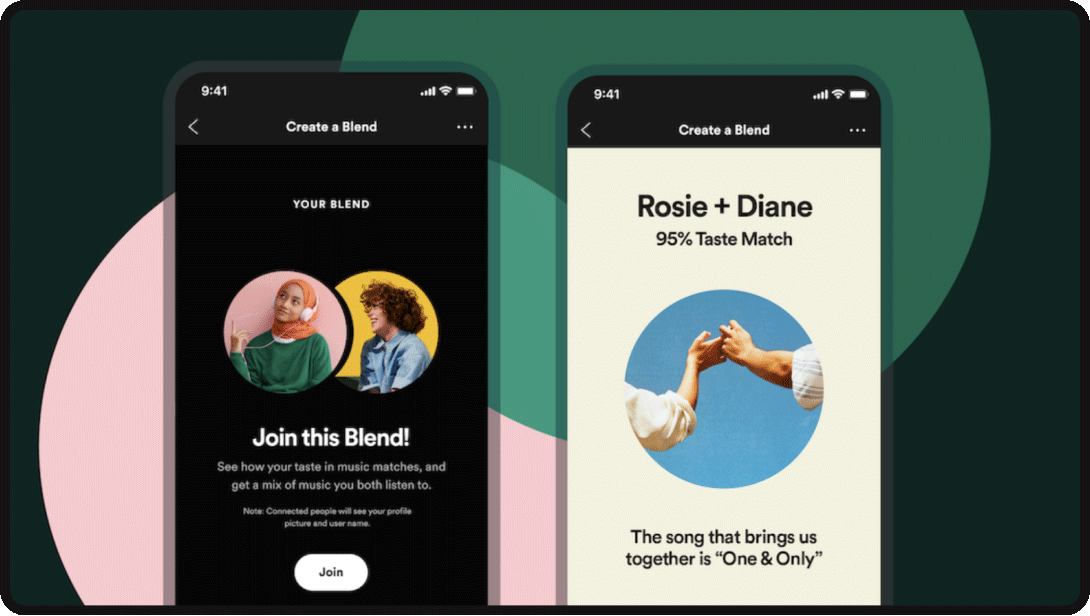
Music is also often seen as a space for connection and love, which is why they created the “Spotify Blend” feature — a daily-updated playlist that combines the music you and another person listen to based on your shared listening activity. For Valentine’s Day, Spotify takes this a step further and allows users to view their personalized taste match score and compare their music tastes to a partner or significant other. It’s a sweet sentiment that is extremely fitting given the inherently emotional nature of music, but it’s also a genius way for Spotify to spur greater engagement and viral sharing.
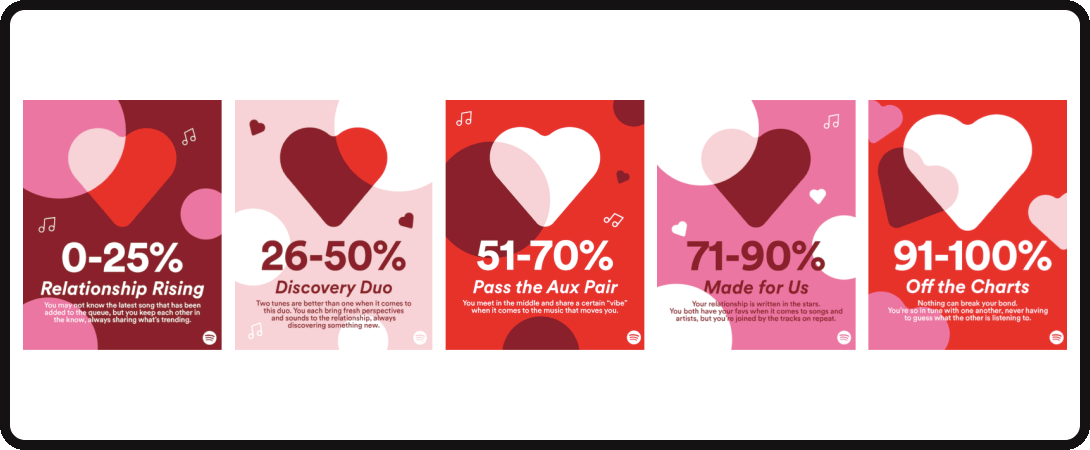
Data
Spotify has access to huge amounts of listener data — so why wouldn’t they use it to their advantage? One of Spotify’s most well-known campaigns was all about data, yet it somehow still felt incredibly human and relatable. What Spotify did was they pulled user insights from large amounts of data, and framed those findings in a way that still feels deeply human. The result was a campaign that combined humor with leveraging user data, making users feel like they’re a part of a larger community of listeners.
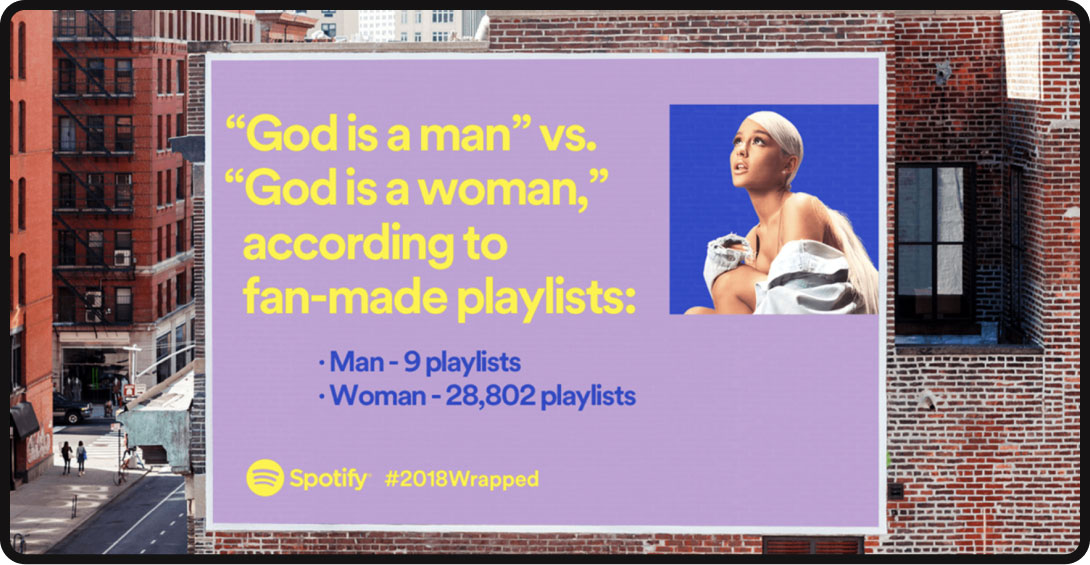
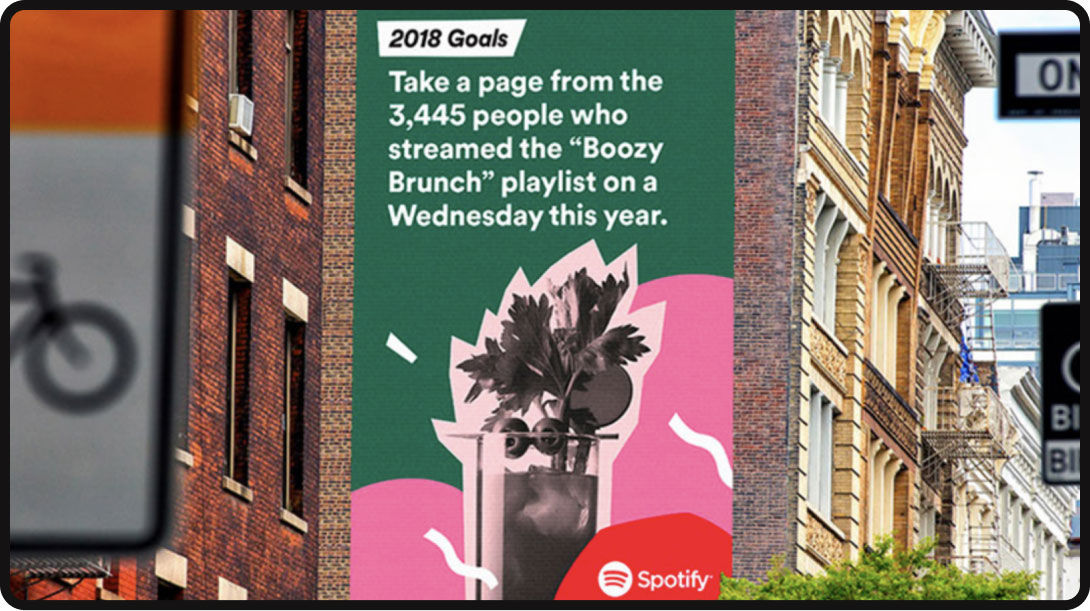
Who Is The Target Audience of Spotify?
Spotify’s target audience skews towards the younger Gen Z and Millennial generations, with a slight female majority and a geographical focus on the United States, Europe, and Latin America. That being said, Spotify’s audience is still incredibly diverse, with users in over 184 different countries and markets. This diversity calls back to the importance of user personalization, so that Spotify can create a customized experience for each user that is specific to their listening habits and music preferences.
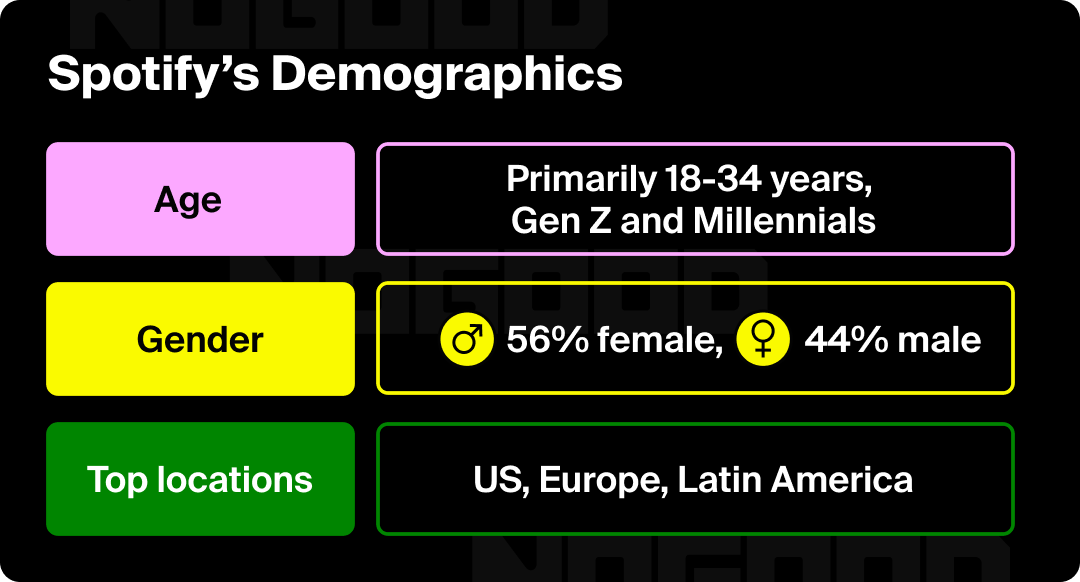
What Are The 4 Ps of Marketing For Spotify?
Now that you understand the main pillars of Spotify’s marketing strategy, here are the 4 Ps of Spotify’s marketing.
Product: A look into a Spotify’s vertical scroll discovery
One of the biggest features Spotify announced at their 2023 Stream On event was a new mobile interface built for deeper discovery. Much like TikTok or Instagram, there’s a vertical scroll that allows users to explore new album covers, short canvas clips or recommended podcasts. This fundamental change in the product interface reflects an overall shift towards a more discovery-focused model, where users not only listen to music they like but also find new songs and albums that are similar to their listening tastes.
One thing is clear: Spotify is no longer just a music streaming platform. With this new interface, Spotify is borrowing elements from TikTok, Instagram, and Youtube, thus turning Spotify into a holistic experience encompassing not only audio, but also short-form video, album art, and more.
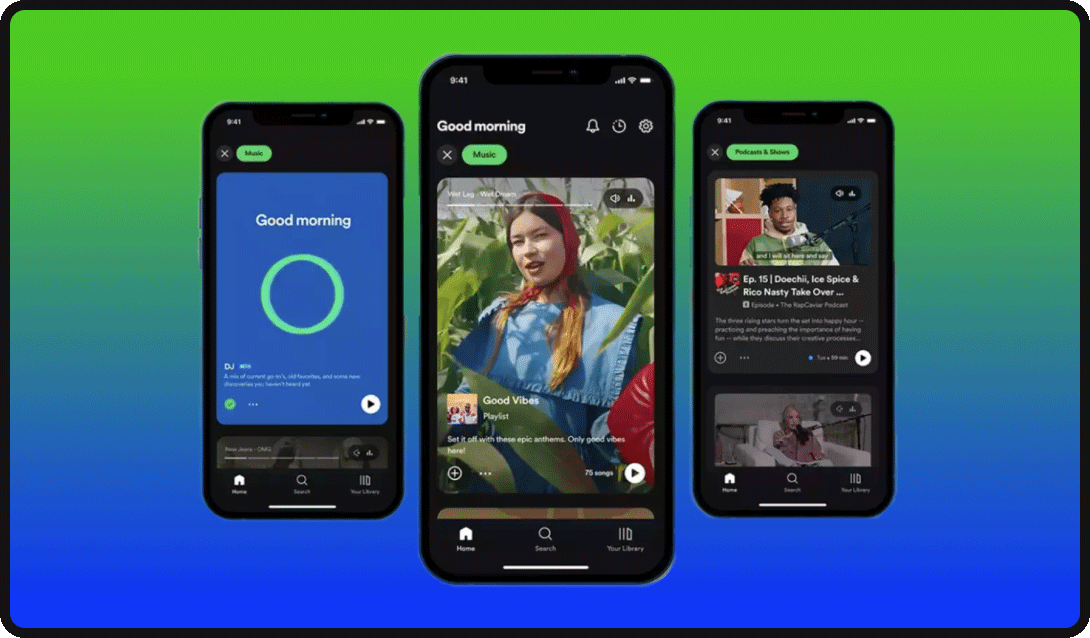
It’s important to note that this more discovery-based approach may be Spotify’s attempt at solving the issue that they’ve been having with podcasts recently. Spotify acquired podcast production house Gimlet Media in 2019 for a reported $230 million, and purchased The Ringer network in 2020; all in all, Spotify spent over $1 billion as an investment into the podcast category.
Despite the ambitious investment, Spotify’s podcasts are not yet profitable, and the platform only brought in roughly $215 million in revenue through podcasts in 2021. The benefit of the vertical scroll discovery format is that it gives users a new avenue to discover new content, and empowers creators to share and promote their content within the platform. Will this discovery model solve Spotify’s podcast problem? Only time will tell — but it was definitely a strategic move on their part.
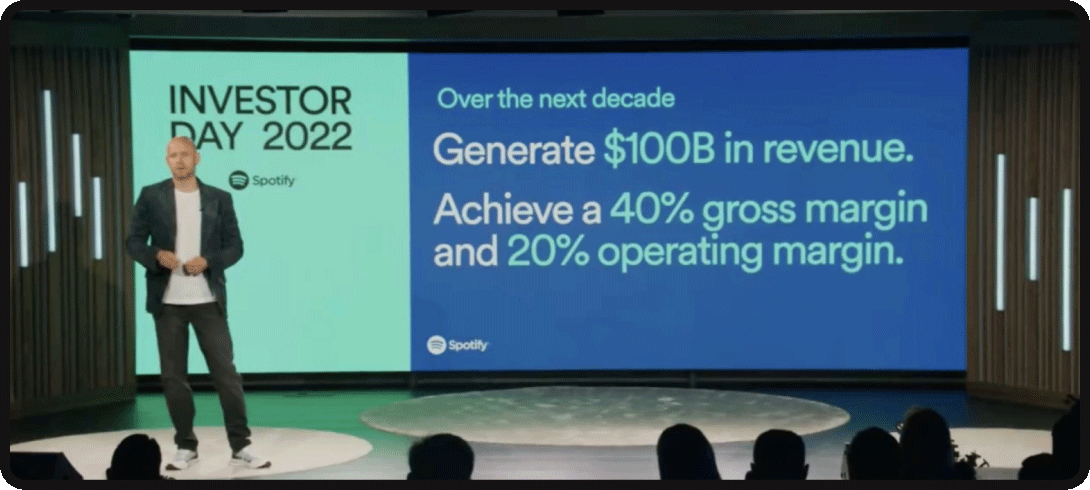
Price: The freemium model in action
Spotify’s pricing strategy uses a freemium model that offers a basic service for free and an unlimited, ad-free premium service for a subscription fee of $11.99 a month — or $19.99 for a family plan. The advantage of this freemium business model is that Spotify can attract and acquire a large number of users through the appeal of a free service, and then convert those users to paying subscribers once they have already established a positive relationship with the customer. Evidently, the freemium model has been working for Spotify, as they have a 46% conversion rate to paid services, compared to just 30% for Apple Music, 25% for Amazon Music, and 15% for YouTube Music.
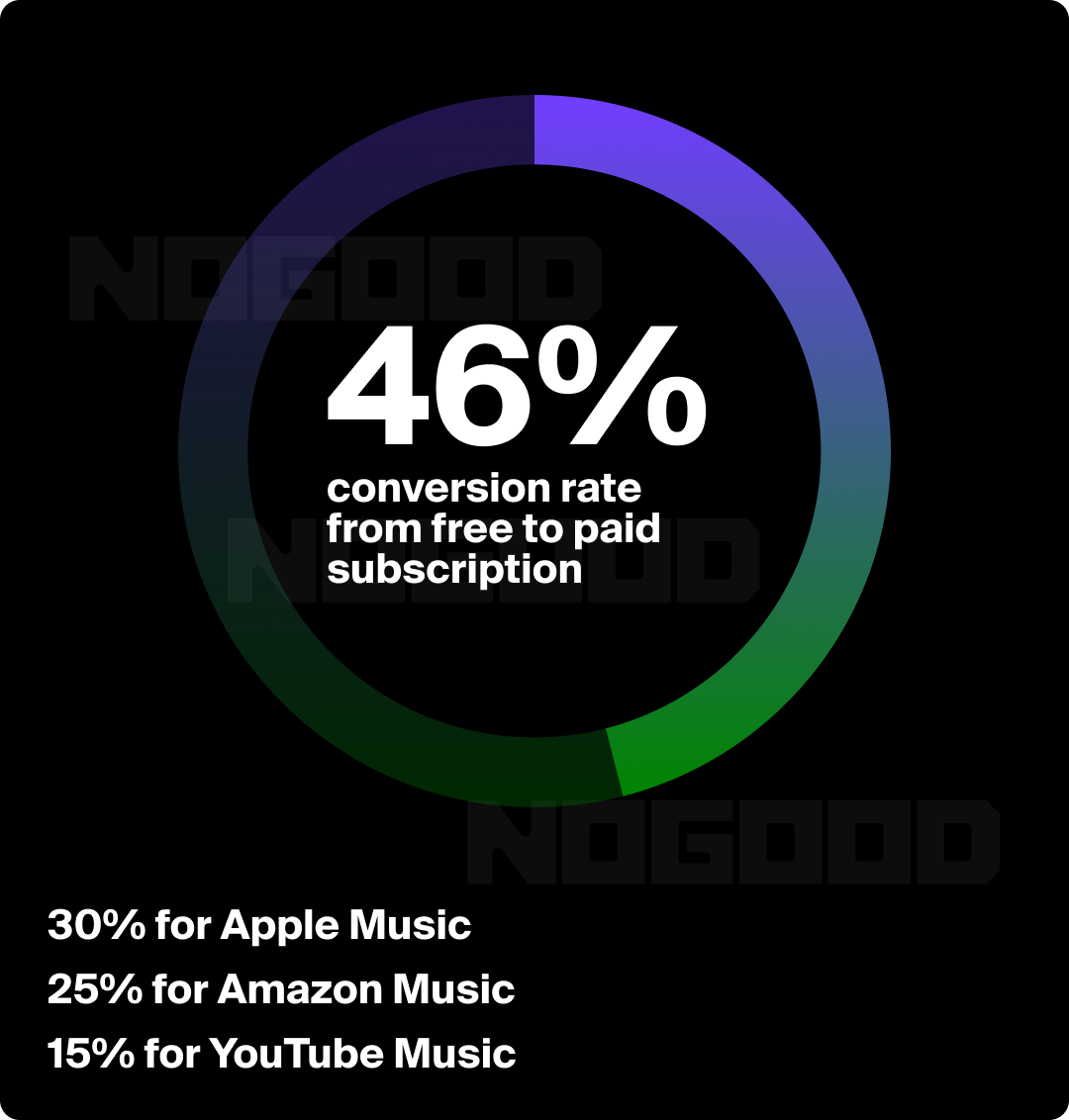
The challenge with a freemium model comes later at the retention stage, as Spotify would have to continually retain their paying customers to maintain their stream of subscription revenue. Despite their immense new user growth, Spotify maintains a 75% retention rate – demonstrating their strength in not only acquiring new users but also keeping them.
At the heart of Spotify’s retention strategy is their ability to capitalize on the social and network effect of listening behaviors. Once a user subscribes to Spotify, they become part of a larger network of Spotify users, and they feel connected to that community through following a friend’s playlist, making blended playlists, or comparing their Spotify wrapped top artists. Once Spotify is able to give a user a sense of belonging, they’re more likely to continue paying for the platform in order to continue engaging with others through the platform’s social sharing features.
Promotion: The art of engineered virality
Since its launch in 2016, Spotify’s viral “Spotify Wrapped” marketing campaign has dominated online conversations and social media platforms every December. The campaign was so popular that it became some sort of an annual tradition or a rite-of-passage for die-hard Spotify users.
In addition to being widely shared on social media, Spotify Wrapped is also the subject of countless memes, satirizations, and copycat recreations. It went from marketing campaign to viral social phenomenon and quickly rose to its status as the prime example of engineered virality and the power of social media trends.
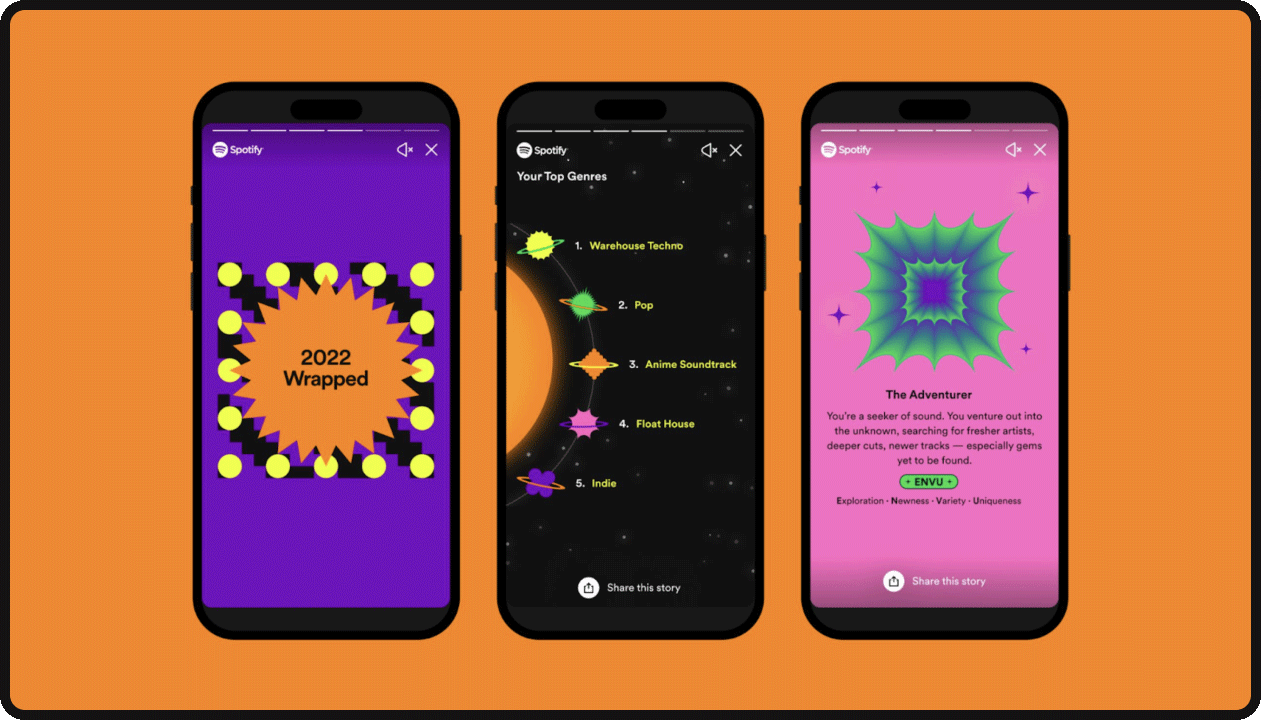
On the surface, Spotify Wrapped was created with the goal of giving users an opportunity to better understand their music tastes and celebrate a year of listening by looking back at their favorite songs, artists, and genres; but that’s only the beginning of it.
Spotify Wrapped was created with the behaviors of social sharing in mind. Spotify recognized that music is by nature something that people like to share and show off, so they took that natural instinct and turned it into a tool for engineered virality and rapid word of mouth.
Every part of the Spotify Wrapped function was designed and optimized for social sharing: 9:16 image dimensions were ready for Instagram Story posts, colors were designed to be eye-catching and attention-grabbing, and “share” buttons were scattered throughout the entire experience. Every time a user shared their Spotify Wrapped on their story, they were directly contributing to the viral loop of social sharing by reminding their own follower network to do the same.
Most brands would go to great lengths to replicate the distinct and singular success of the annual Spotify Wrapped moment, and many have deigned to simply follow along in the footsteps of what’s already been proven to work. This repeatable, unmistakable synthesis of brand, product, and user-first marketing strategy has become a social-media-led cultural moment on par with the Super Bowl, but 2024 exposed some cracks in the inimitable success. Users were vocal in rejecting the updates prioritizing artificial intelligence features and the lack of innovative presentation from years past.
For a company that clearly thrives from community advocacy, this misstep was noticed by the broader industry as rivals and even unrelated category brands took their chance to poke fun at the perceived blunder.
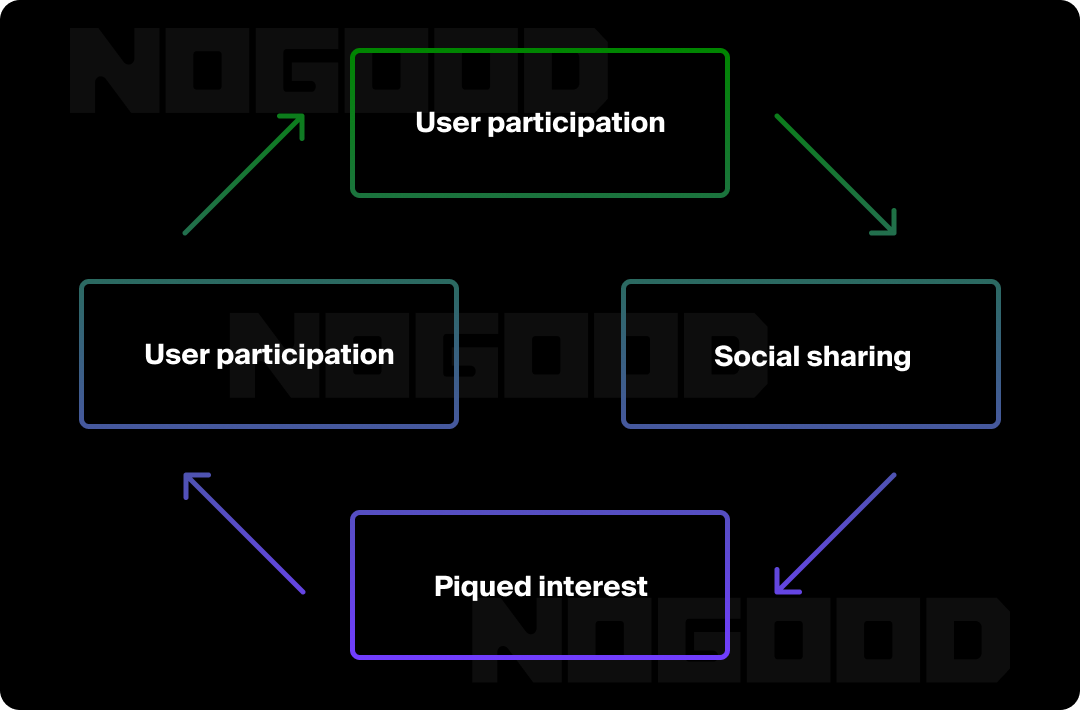
Genius? Yes. Organic, cost-effective, and sustainable? Yes, yes, and also yes.
Place: Expanding beyond the app
As any modern tech company understands, the battle for user attention is among the most significant challenges facing even the most advanced media conglomerates. Spotify decided to respond to this existential threat with a redesign meant to feel comparable to scrolling through TikTok’s never-ending feed, even generating background visuals for music as well as prioritizing podcasts that featured full-screen video.
Spotify was the first music-streaming brand to have a presence on Roblox, marking a significant change in how we think about “place” when it comes to music streaming platforms. In terms of place, Spotify exists across any device that can access the app — be it a smartphone, laptop, smart speaker or voice-activated home assistant.
The launch of “Spotify Island” represented an external transformation of the in-app experience — a “paradise of sound” where fans and artists from all over the world could connect and explore a digital world of sounds, quests, and exclusive merch. With this expansion, Spotify pushes the boundaries of physical and digital spaces by creating a virtual universe to foster greater community and brand awareness.
With Spotify Island, the music streaming platform was no longer limited to its app; rather, it became a recognizable brand that transcends its functional manifestation. Spotify Island is designed to be incredibly true to its brand, with lots of green, music easter eggs, and shapes and icons that users will recognize from the app’s interface.
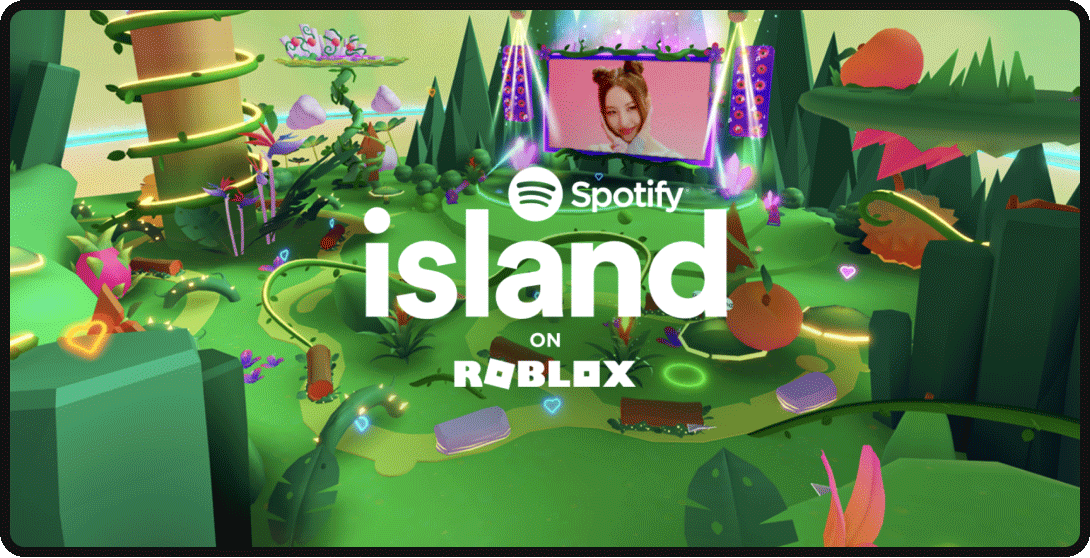
On Spotify Island, users can mingle with artists, complete interactive quests, and unlock exclusive content. By creating a space where artists and listeners can interact with each other and with the brand in a whole new way, Spotify is able to immerse users in the world of their holistic brand identity, no matter how and where they choose to listen to their music.
How Does Spotify Market Through Social Media?
In addition to Spotify’s now-viral Spotify Wrapped campaign, the tech company is skilled in marketing their platform through social media in a variety of different ways. At the core of their social media strategy is the principle that music can and should be a cross-platform experience, one that is not limited to the confines of the Spotify app itself; we already see this happening in their experiments with emerging technology but this is apparent in their approach to social media as well.
Every single experience and touchpoint on the Spotify app is designed to be easily shared across a variety of social media platforms, a move which is just as strategic as it is convenient. Internal reporting revealed that Gen Z listened to 1.2 trillion songs on Spotify in 2023 alone. While previous generations of music listeners may have been flipping through CDs at the malls or searching for vinyls at their local record store, today’s modern music listeners are seeking out new tracks and artists through social media. Evidence of this avid behavior of music discovery through social media proves particular importance for Spotify to hone in on their cross-platform experience and enable seamless discovery of their music.
Spotify is not only marketing through social media, but they’re also evolving their product to replace behaviors that used to primarily exist on social media. In other words, much like social platforms like TikTok or Instagram, Spotify is broadening its offerings to become a space for eCommerce, music news, and information search in addition to music streaming.
In their recent partnership with Shopify, artists can now sell their merch and/or concert tickets directly through the Spotify app. This “retail-ification” of the music streaming app is a win-win for both artists and Spotify, as it gives artists a platform to promote their work in the app itself, and it likely increases the amount of time that Spotify users spend on the app. Hence, in a strange chicken-or-egg situation, Spotify is simultaneously promoting itself through social media, and evolving to become a social media platform in itself to become less reliant on social media platforms in the future.
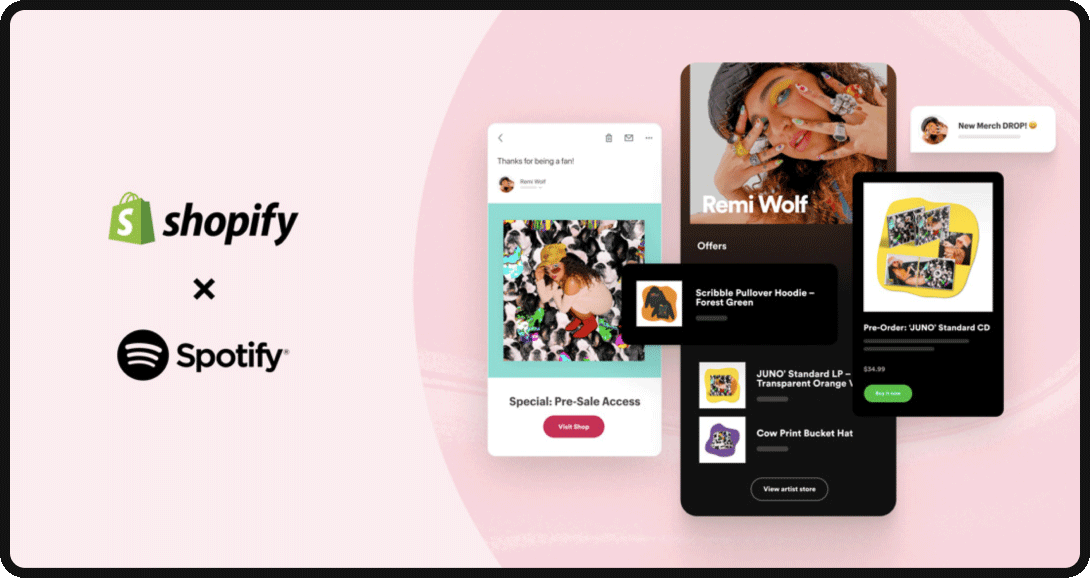
What’s Next for Spotify?
There’s no denying that Spotify has been widely successful in their marketing strategy these past years — and they have the numbers to prove it. At the start of this year, Spotify revealed their significant contribution of $10 billion to the music industry in 2024, a record for any single retailer and bringing their lifetime total to nearly $60 billion.
Still, in order for Spotify to retain its existing user base and maintain its success as listening habits and the landscape of user behavior continue to rapidly evolve, the platform must also evolve to fulfill the diverse needs of today’s modern consumer.
Will Spotify’s podcast priority contribute to a spike in hours of video watched? Will Spotify Wrapped continue to go viral year after year? Will their artificial intelligence experiments transform the way people engage with music on a daily basis? Spotify has many challenges ahead of themselves, but if their history of strategic thinking shows anything, it’s that this is a company that truly knows how to push the boundaries of growth and innovation.
Want to keep up with the latest and greatest in growth marketing?



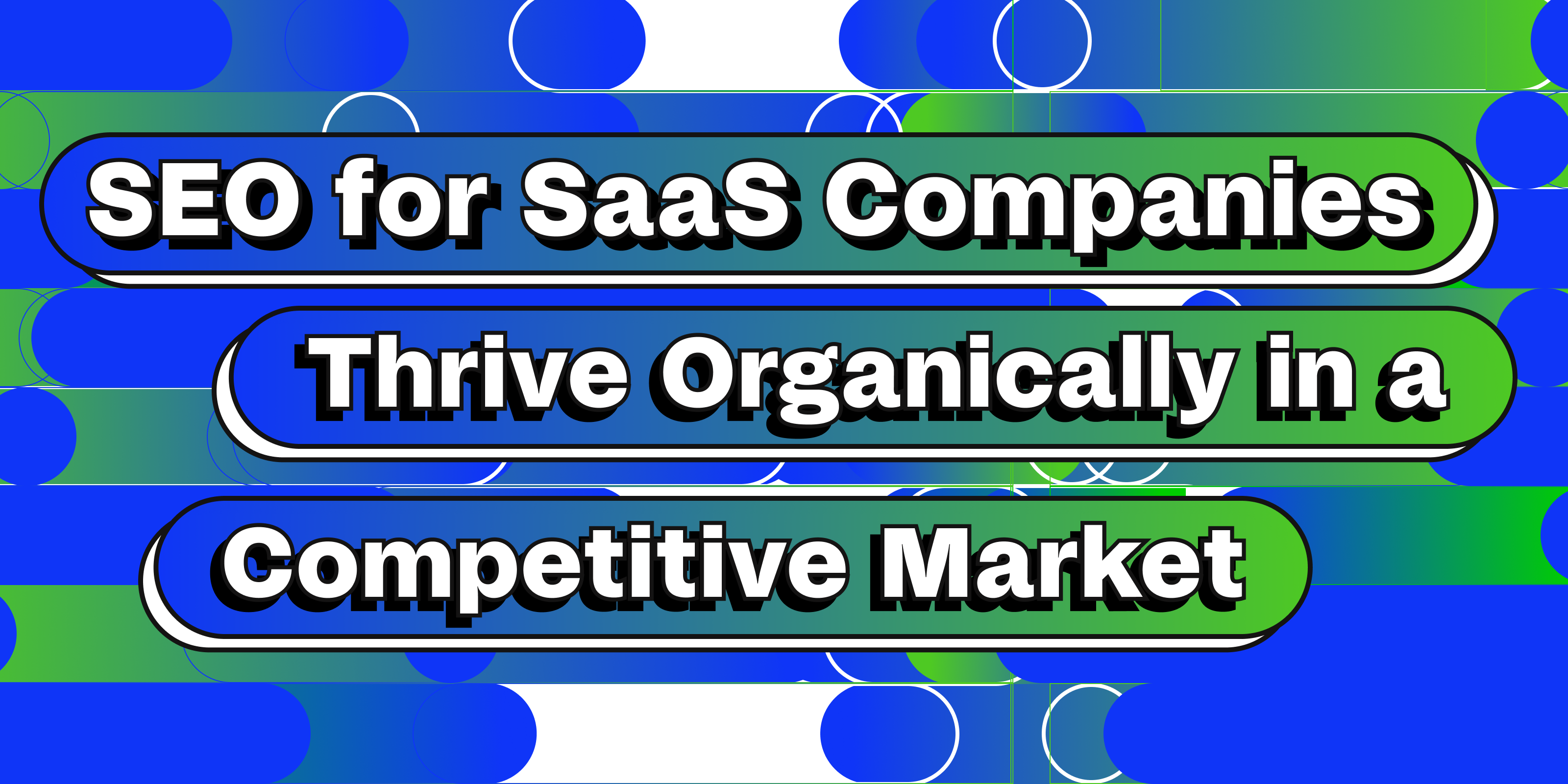

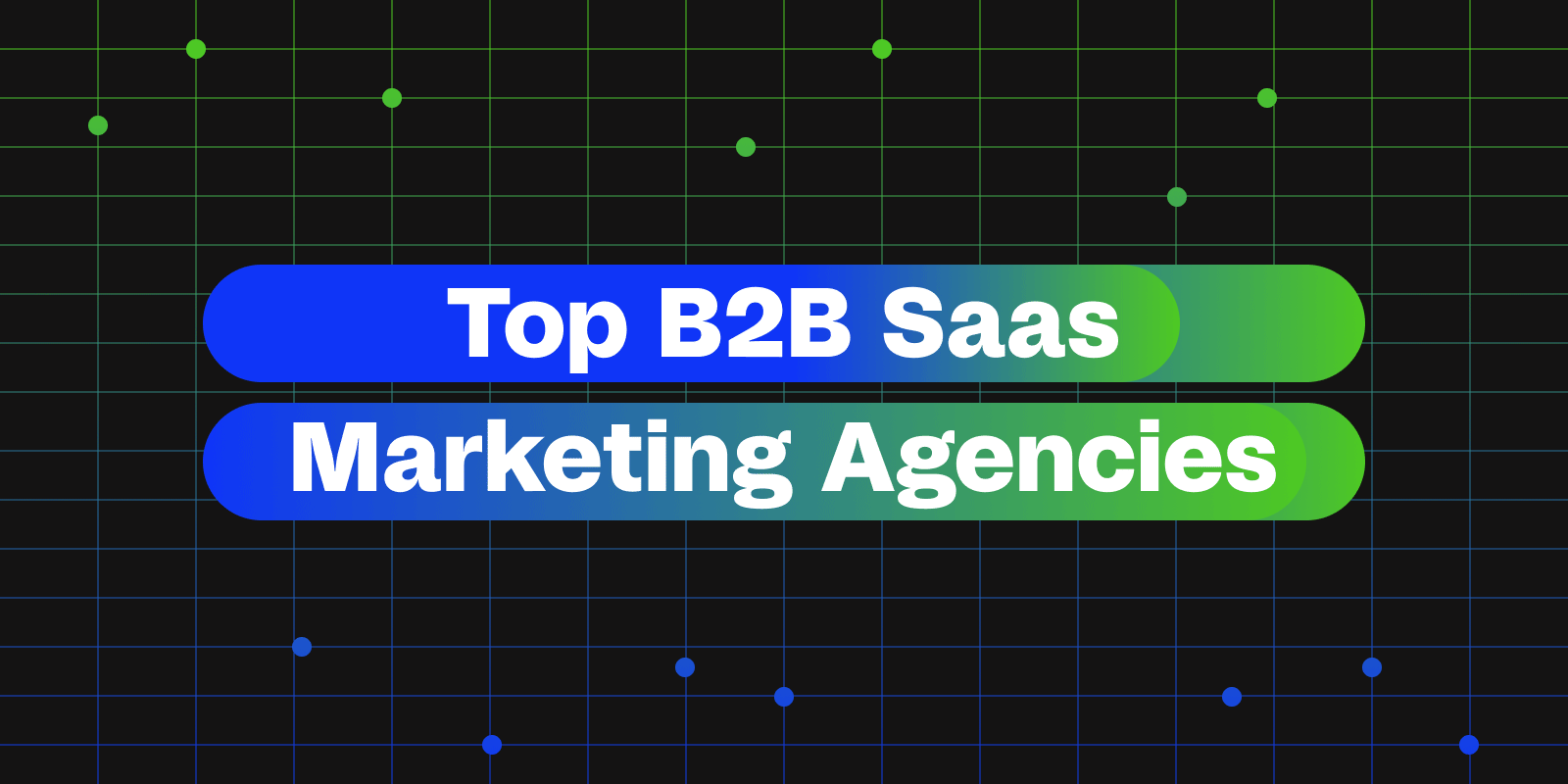

This was such a fucking great read, thank you so much for sharing such nuanced insights